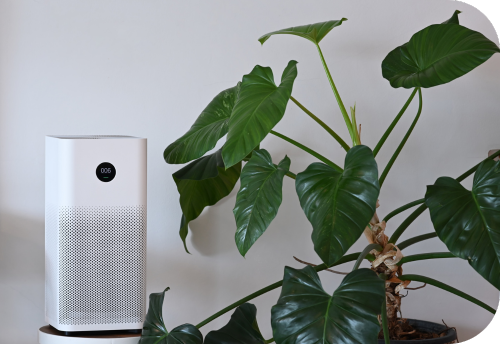Clicking on this means you are interested in learning 6 tips to improve indoor air quality in your home
Outside, the winter chill blankets the ground with layers of snow, urging us to keep our doors and windows tightly shut. But did you know that, according to the Environmental Protection Agency (EPA), people spend 90% or more of their time indoors?
In today’s world, builders construct newer homes with tight insulation and energy-efficient designs, which minimize air exchanges between indoor and outdoor environments. While this is great for keeping our homes warm and reducing energy costs, it also creates a less-than-ideal scenario for indoor air quality.
When our homes seal tight, pollutants can accumulate indoors, leading to poor air quality. We often associate air pollution with outdoor sources like car emissions, but indoor air can be just as polluted. Common culprits include dust, pet dander, mold spores, volatile organic compounds (VOCs) from household products, and even cooking fumes.
Why does indoor air quality matter? The air we breathe indoors directly impacts our health and well-being. Poor indoor air quality can trigger or exacerbate respiratory issues like asthma and allergies, cause headaches, fatigue, and even long-term health problems with prolonged exposure.
Fortunately, there are steps we can take to improve indoor air quality. Regular cleaning and maintenance, proper ventilation, and using air purifiers help reduce indoor pollutants. These actions promote a healthier living environment. Paying attention to air quality in our homes creates a safer, more comfortable space for ourselves and our loved ones.
There’s a growing body of scientific evidence confirming indoor air pollution surpasses outdoor air pollution. Toxic chemicals pervade our surroundings. As parents, we strive to keep our kids safe, though it’s not always easy or within our control. We’re all exposed to toxic chemicals daily through various consumer products in our homes.
Studies by the Environmental Working Group have revealed that hundreds of toxic chemicals, including pesticides, fire retardants, and PCBs, are present in the umbilical cord blood of newborns. It’s no surprise – our homes are saturated with toxins. Mattresses contain harmful chemicals, and couches harbor cancer-causing agents.
What can you do to improve indoor air quality in your home?
1. No VOCs: Most conventional paints contain high levels of Volatile Organic Compounds (VOCs), which emit a breathable gas when slapped on your walls. VOCs are not your friend. Once released, down goes the air quality in your home, and headaches, nausea, and dizziness can occur. Long-term exposures to the fumes have been linked to a number of disorders including cancer, kidney disease and liver damage. The next time you plan to paint, consider choosing a low VOC or no VOC paint that is free of nasty fumes.
2. Avoid Synthetic Scents: Air fresheners, cleaning supplies and other scented products can contribute to indoor air pollution. Read labels and find products without toxic chemicals and synthetic “fragrance”.
3. Test for Radon: You can’t see or smell radon, but it could be in your home. Radon comes from the natural breakdown of uranium in soil, rock, and water. It then seeps into your home and the air you breathe. Testing is inexpensive and simple and the only way to know if you and your family are at risk from radon. January is National Radon Action Month.
4. No Smoking Zone: Tobacco smoke is a major contributor to indoor air pollution. Tobacco smoke contains more than 7,000 chemical compounds. More than 250 of these chemicals are known to be harmful, and at least 69 are known to cause cancer. Children exposed to secondhand tobacco smoke are at increased risk for ear and respiratory infections, asthma, cancer, and sudden infant death syndrome (SIDS). Make your home a no-smoking zone.
5. Take your Shoes off at the Door: Declare your home a “shoe free” zone. Shoes track into the home all sorts of toxins from the outside that could impact your indoor air quality. Asking family and guests to take of their shoes before they enter your home will create a healthier, safer environment for all.
6. Houseplants help Clean the Air: Many common houseplants act as an air filter, removing toxins from the air we breathe. They produce oxygen from CO2 and absorb toxins like benzene (found in gasoline, ink, oils, paint, plastics, and rubber), formaldehyde, and trichloroethylene (found in printing inks, paints, lacquers, varnishes, and adhesives). A few years ago, NASA recommended using 15 to 18 large houseplants in 6 to 8-inch diameter containers to improve air quality in an average 1,800 square foot house.
Now that you know the 6 tips to improve indoor air quality, you can start to live a healthier home life. Take charge of keeping your home safe. Contact us with any questions, anytime. 612-789-9600.
Prev: Mold & Water – Enemies of the HomeNext: The Powerful Benefits of Clean CarpetView All Resources